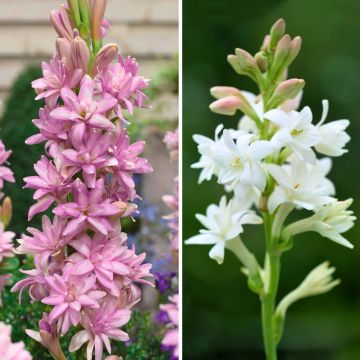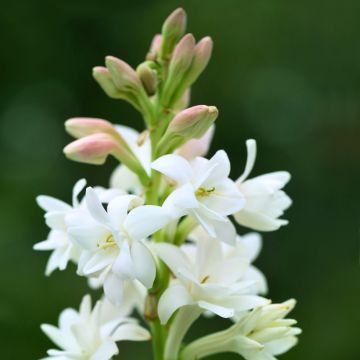

Lilium (x) longiflorum Calabria - Easter Lily
Lilium (x) longiflorum Calabria - Easter Lily
Lilium (x) longiflorum Calabria
Easter Lily, Trumpet Lily
Special offer!
Receive a €20 voucher for any order over €90 (excluding delivery costs, credit notes, and plastic-free options)!
1- Add your favorite plants to your cart.
2- Once you have reached €90, confirm your order (you can even choose the delivery date!).
3- As soon as your order is shipped, you will receive an email containing your voucher code, valid for 3 months (90 days).
Your voucher is unique and can only be used once, for any order with a minimum value of €20, excluding delivery costs.
Can be combined with other current offers, non-divisible and non-refundable.
Home or relay delivery (depending on size and destination)
Schedule delivery date,
and select date in basket
This plant carries a 6 months recovery warranty
More information
We guarantee the quality of our plants for a full growing cycle, and will replace at our expense any plant that fails to recover under normal climatic and planting conditions.
Would this plant suit my garden?
Set up your Plantfit profile →
Description
The Lilium 'Calabria', a Longiflorum-Asiatic (LA) hybrid lily, is a recent variety distinguished by its intense reddish-purple colour with brown highlights and its impressive flowers, facing upwards. This lily truly catches all eyes, and its elegance shines both in borders and vases. The plant blooms at the end of June, on a long, sturdy stem adorned with beautiful glossy dark green foliage. This variety is disease-resistant and tolerates cold well, in well-drained soil.
The 'Calabria' lily belongs to the lily family, resulting from a cross between Longiflorum and Asiatic lilies: it is an LA hybrid. LA hybrids combine the strength and resistance of Asiatic lilies with the elongated shape and light fragrance of Longiflorums. Depending on the bulb size, this cultivar reaches a height of 1.10 m to 1.35 m. It develops an upright, elegant vegetation. Its flowers, with a diameter of 15 to 20 cm, display a sumptuous deep red-violet colour, with subtle reddish-brown tones towards the base, adding depth to each petal. A colour enhanced by the glossy texture of the broad petals. The flowering is early and usually occurs from the month of June onwards, depending on the climate. The 'Calabria' flowers are slightly fragrant. They open in a cup shape, each formed of smooth petals, sometimes slightly undulating. The glossy dark green foliage, composed of lanceolate leaves measuring 20 to 25 cm, pleasantly contrasts with the flower hues. The sturdy, purple-coloured stems bear several umbels of 3 to 4 flowers. This cultivar is also known for its disease resistance, particularly against leaf scorch. The vegetation dries in autumn, while the bulb enters dormancy. Bulbs are storage organs with fleshy, overlapping scales.
The Lily 'Calabria' is interesting for structuring a border or creating large colourful borders. It can also be cultivated in a pot to adorn the terrace or balcony. Its impressive flowers with intense colours pair well with grasses like Pennisetum x advena 'Rubrum', perennials like purple heucheras 'Forever Purple', purple asters (Aster amellus 'Sonora'), and silvery lavenders such as 'Richard Gray'. This lily holds up well in a vase where it charms with its classic elegance. Winter protection, in the form of a thick mulch, is not unnecessary in very cold regions.
Longiflorum hybrid lilies like 'Calabria' bloom after 12 or 13 weeks of cultivation, they can be "forced" by planting them early in the season in a conservatory or a warm room. The soil they are planted in should remain moist throughout the growth and flowering period.
Report an error about the product description
Plant habit
Flowering
Foliage
Botanical data
Lilium
(x) longiflorum
Calabria
Liliacées
Easter Lily, Trumpet Lily
Cultivar or hybrid
Other Lilies A to Z
View all →Planting and care
The Lilium 'Calabria' prefers soils that are moist and rich in humus, it does not appreciate very dry, poor, or poorly drained and very clayey soils. It is a variety that can tolerate brief frosts of around -15°C. You should plant it in a sunny spot, in spring or early autumn, burying the bulbs 15 cm deep (about two to three times the size of the bulb) in a pocket of soil mixed with leaf compost. Surround them with a pocket of sand to prevent rot and slug attacks, while allowing them to grow more easily. Mark the planting location, as the vegetation only starts in April.
Growing in a deep pot allows you to overwinter the plant in an unheated, cool, but frost-free location. This method also allows you to "force" the bulb, meaning to advance the resumption of vegetation and the flowering period. To do this, the pot will be stored in a very bright and slightly heated location before the beginning of spring.
When the stems reach 30 cm in height, discreetly stake them. If red insects appear, treat them without delay, as they are lily beetles whose larvae can devour all the leaves. The most effective method is to catch them by hand, but be careful, they drop as soon as they are touched, so put a box underneath. After flowering, it is useful to cut the faded flowers halfway to keep the bed looking beautiful during the summer.
Planting period
Intended location
Care
This item has not been reviewed yet - be the first to leave a review about it.
Similar products
Haven't found what you were looking for?
Hardiness is the lowest winter temperature a plant can endure without suffering serious damage or even dying. However, hardiness is affected by location (a sheltered area, such as a patio), protection (winter cover) and soil type (hardiness is improved by well-drained soil).

Photo Sharing Terms & Conditions
In order to encourage gardeners to interact and share their experiences, Promesse de fleurs offers various media enabling content to be uploaded onto its Site - in particular via the ‘Photo sharing’ module.
The User agrees to refrain from:
- Posting any content that is illegal, prejudicial, insulting, racist, inciteful to hatred, revisionist, contrary to public decency, that infringes on privacy or on the privacy rights of third parties, in particular the publicity rights of persons and goods, intellectual property rights, or the right to privacy.
- Submitting content on behalf of a third party;
- Impersonate the identity of a third party and/or publish any personal information about a third party;
In general, the User undertakes to refrain from any unethical behaviour.
All Content (in particular text, comments, files, images, photos, videos, creative works, etc.), which may be subject to property or intellectual property rights, image or other private rights, shall remain the property of the User, subject to the limited rights granted by the terms of the licence granted by Promesse de fleurs as stated below. Users are at liberty to publish or not to publish such Content on the Site, notably via the ‘Photo Sharing’ facility, and accept that this Content shall be made public and freely accessible, notably on the Internet.
Users further acknowledge, undertake to have ,and guarantee that they hold all necessary rights and permissions to publish such material on the Site, in particular with regard to the legislation in force pertaining to any privacy, property, intellectual property, image, or contractual rights, or rights of any other nature. By publishing such Content on the Site, Users acknowledge accepting full liability as publishers of the Content within the meaning of the law, and grant Promesse de fleurs, free of charge, an inclusive, worldwide licence for the said Content for the entire duration of its publication, including all reproduction, representation, up/downloading, displaying, performing, transmission, and storage rights.
Users also grant permission for their name to be linked to the Content and accept that this link may not always be made available.
By engaging in posting material, Users consent to their Content becoming automatically accessible on the Internet, in particular on other sites and/or blogs and/or web pages of the Promesse de fleurs site, including in particular social pages and the Promesse de fleurs catalogue.
Users may secure the removal of entrusted content free of charge by issuing a simple request via our contact form.
The flowering period indicated on our website applies to countries and regions located in USDA zone 8 (France, the United Kingdom, Ireland, the Netherlands, etc.)
It will vary according to where you live:
- In zones 9 to 10 (Italy, Spain, Greece, etc.), flowering will occur about 2 to 4 weeks earlier.
- In zones 6 to 7 (Germany, Poland, Slovenia, and lower mountainous regions), flowering will be delayed by 2 to 3 weeks.
- In zone 5 (Central Europe, Scandinavia), blooming will be delayed by 3 to 5 weeks.
In temperate climates, pruning of spring-flowering shrubs (forsythia, spireas, etc.) should be done just after flowering.
Pruning of summer-flowering shrubs (Indian Lilac, Perovskia, etc.) can be done in winter or spring.
In cold regions as well as with frost-sensitive plants, avoid pruning too early when severe frosts may still occur.
The planting period indicated on our website applies to countries and regions located in USDA zone 8 (France, United Kingdom, Ireland, Netherlands).
It will vary according to where you live:
- In Mediterranean zones (Marseille, Madrid, Milan, etc.), autumn and winter are the best planting periods.
- In continental zones (Strasbourg, Munich, Vienna, etc.), delay planting by 2 to 3 weeks in spring and bring it forward by 2 to 4 weeks in autumn.
- In mountainous regions (the Alps, Pyrenees, Carpathians, etc.), it is best to plant in late spring (May-June) or late summer (August-September).
The harvesting period indicated on our website applies to countries and regions in USDA zone 8 (France, England, Ireland, the Netherlands).
In colder areas (Scandinavia, Poland, Austria...) fruit and vegetable harvests are likely to be delayed by 3-4 weeks.
In warmer areas (Italy, Spain, Greece, etc.), harvesting will probably take place earlier, depending on weather conditions.
The sowing periods indicated on our website apply to countries and regions within USDA Zone 8 (France, UK, Ireland, Netherlands).
In colder areas (Scandinavia, Poland, Austria...), delay any outdoor sowing by 3-4 weeks, or sow under glass.
In warmer climes (Italy, Spain, Greece, etc.), bring outdoor sowing forward by a few weeks.









































